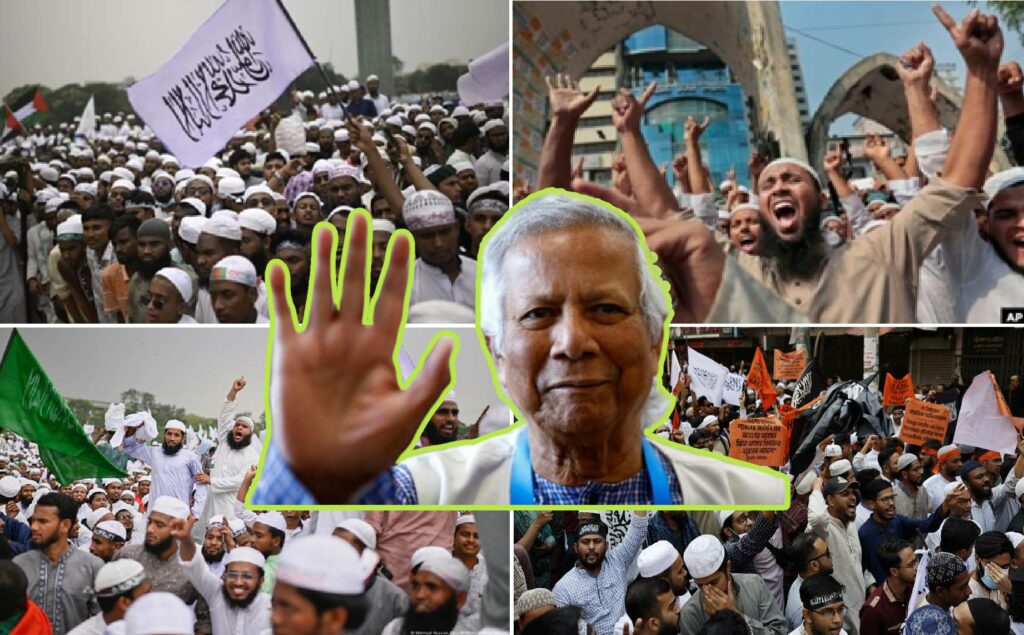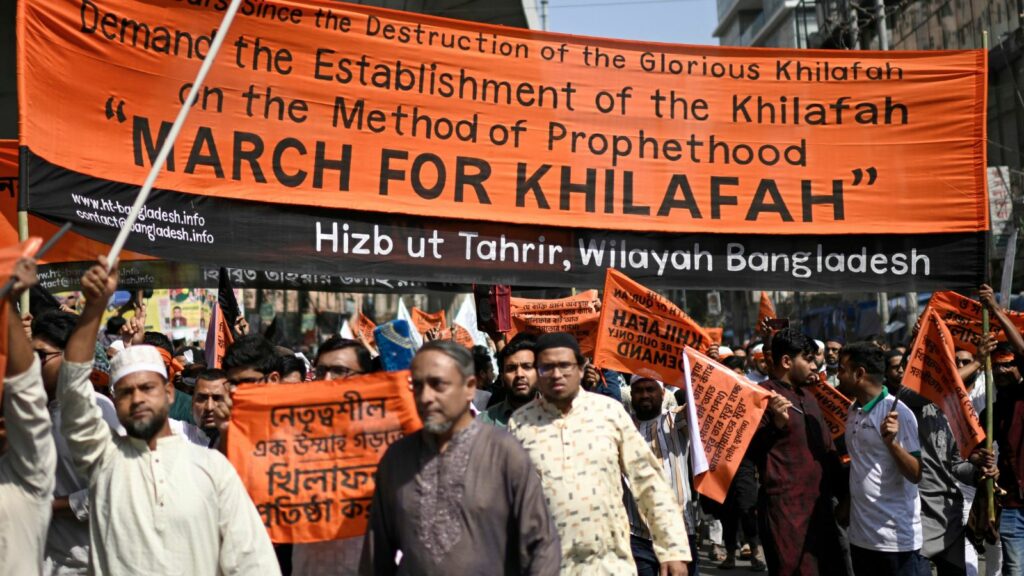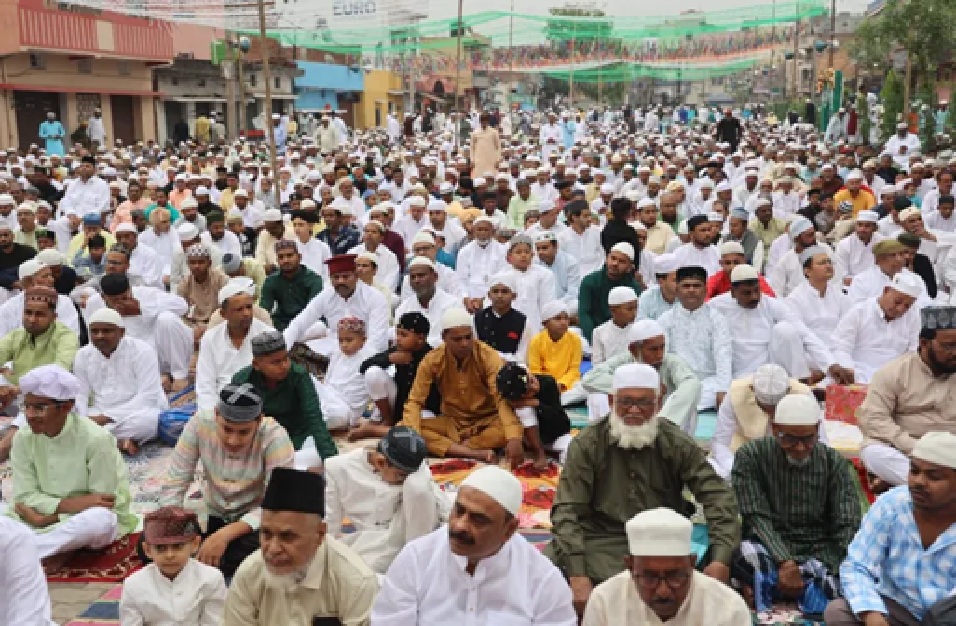
- One of the most obvious signs of an Islamist resurgence in Bangladesh is the re-invention of Jamaat-e-Islami (JEI) as a formal political party.
- Counterterrorism experts think that agencies have been consciously emasculated, or at least the capability is being whittled down, diminishing the suppression effectiveness of extremist movements.
- Media reports and intelligence assessments indicate that the border districts of West Bengal and Assam have already experienced ideological infiltration.
- For Bangladesh, the principal challenge will be to contain this increase in methods that maintain the constitutional guarantees of secularism, safeguard minorities, and apply the law without political inclination or abuse of power.
The political situation in Bangladesh has changed abruptly after August 2024. The removal of Sheikh Hasina’s long-term government, the emergence of the interim government headed by Muhammad Yunus, and the resulting constitutional, legal, and security developments have introduced an environment of transition. Among the multitude of forces at work, one that has attracted growing attention both within Bangladesh and beyond its borders is the return to influence or revival of Islamist networks—political, ideological, and in some instances violent—and their beginnings of activism, recruitment, and reach. These trends are impacting the security environment both within and for neighbouring India, specifically its northeastern region and its littoral face in the Bay of Bengal.
In this article, we will talk about these Islamist networks: who they are, how they function, how they’re networked regionally, what Bangladesh is up against, and how India is affected.
Who Is Resurgent, And How
Political Islam And Party Politics
One of the most obvious signs of an Islamist resurgence is the re-invention of Jamaat-e-Islami (JEI) as a formal political party. The Bangladeshi Supreme Court reinstated JEI’s registration, and that of its associated student wing, Chhatra Shibir, in 2025, re-opening options that were previously inhibited. This restoration to legal status is read by many as more than just re-institutionalising formerly banned political action groups; it represents a real shifting of power of some magnitude under the Yunus government, linking Islamist actors and their partisan support to the legitimate political process.
Jamaat-e-Islami has, for years, been excluded from participation in public life and has been restricted under previous governing authorities with a heavy hand. However, household reports JEI is now negotiating adjacent factional parties- including student-led groups, born of 2024 protests, to explore opportunities for power-sharing between their openings. Other sources also report that JEI has been meeting with visiting Chinese political delegations, where they have proposed an independent Rohingya state in Myanmar’s Rakhine, likely as a means to politicise a transnational Islamist and Rohingya solidarity, and also use it for their own purposes domestically.
Mobilisation, Radical Ideology, And Fringe Actors
Aside from JEI, lesser Islamist or radical extremist fringe elements are said to be active. Hardline factions such as Ansarullah Bangla Team (ABT), Hizb ut-Tahrir, and IS/IS-K networks have been referred to in some intelligence‐type reporting or media analysis as having become visible again. The types of activities include:
- Expanded public “seminars” or religious meetings, which, though presented in spiritual or cultural language, are said to be used to disseminate more radical or puritanical teachings, at times directed at young men and university students.
- Religious minorities (like Hindus, Ahmadiyyas) are victims of violence, intimidation, and desecration of sites of worship or other religious,–and occasionally secular or Sufi shrines–that are now protected from being desecrated. There have also been various incidents of women being harassed (especially women who are deemed violators of conservative norms), as Islamists experiment with the limits of acceptability.
- Activities on the margins of legality: release or arrest of militants, dubious legal cover, or indulgence in prosecutions. The “eviscerated counterterrorism strategy” of the Yunus administration is quoted often enough. Some counterterrorism experts or intelligence analysts think that agencies have been consciously emasculated, or at least the capability is being whittled down (through transfers, resignations, or political pressures), diminishing the suppression effectiveness of extremist movements.
- Recruitment in social/physical spaces: among young people (college campuses), and potentially through martial arts or gym centres, although the latter is less convincingly documented in the most recent sources.

Transnational Linkages: Rohingya, Regional States, Foreign Ideological Influence
The Bangladeshi Islamist resurgence does not operate in isolation. Key regional and transnational connections are evident or strongly suspected. Rohingya insurgency, border zones, and ARSA. One of the most concrete developments is the arrest by Bangladeshi security (in 2025) of Ataullah Abu Ammar Jununi, commander of ARSA (Arakan Rohingya Salvation Army), along with other members. Charges include illegal entry, sabotage, and terrorist activities. This is significant because it demonstrates ARSA’s ability to operate or establish agents or cells inside Bangladesh, not just in camps or on the Myanmar side.
Additionally, the South Asia Terrorism Portal (SATP) reports that ARSA‐linked incidents of violence (attacks, clashes) have occurred within Bangladesh, with significant casualties over the years (both civilians and militants) in border or refugee-affected areas.
Proposed independent Rohingya state, external outreach: As mentioned, JEI’s outreach to Chinese delegates proposing a Rohingya state points to Islamist political actors using the Rohingya issue to build foreign alliances and ideological leverage. Whether this proposal has any realistic backing or is more symbolic is unclear, but it is part of the narrative of Islamist actors expanding their horizon beyond purely domestic politics.
Foreign ideological/financial influence: Some Indian‐sources report concern over Turkey’s deeper role in Bangladesh, particularly as it pertains to Islamist groups. These reports allege that Turkish organisations or entities (some linked to its intelligence/intelligence-adjacent actors) have been involved in funding or facilitating Islamist ideology growth in Bangladesh — for example, via renovation of JEI offices or facilitating visits of Islamist leaders.
Border porosity and migration/infiltration routes: While less documented with open sources, there are repeated claims in Indian media or intelligence assessments that individuals with radical Islamist sympathies, or even militants, are exploring or exploiting the porous borders, especially in the border districts of West Bengal and Assam, either for ideological propagation, recruitment, or safe relocation.
How This Spills Over Toward India: Northeast & Bay Of Bengal Considerations
India shares long land and maritime frontiers with Bangladesh. Thus, developments in Bangladesh rarely stay contained. Here’s how the recent Islamist resurgence in Bangladesh is already or potentially affecting India, especially its northeast, and the security of the Bay of Bengal region.
Northeastern India — Land Border Issues
Infiltration and radical influence: Media reports and intelligence assessments indicate that the border districts of West Bengal and Assam have already experienced ideological infiltration. Radical sermons, publications, and propaganda are reportedly crossing over. Policing the porous international border, particularly in rural, wetland, riverine, or forest areas, is difficult.
Communal tensions and refugee flows: In Bangladesh, any assault on a group of minorities, even though it may be relatively small, generates migratory or refugee movement (or at least fear of movement) across the border. There is a considerable population in West Bengal with connections across the border, connections of shared ethnicity, shared language, and shared culture; tensions in Bangladesh reverberate across. Additionally, any perceptions of weakness or impunity in Bangladesh tend to embolden the communal narratives in India. Violence in Bangladesh against Hindus or other minorities thus creates social-political resonance in India.
Border security measures: As a reaction, India’s security agencies (BSF) have increased patrolling and surveillance on vulnerable stretches. Night‐time curfews or restrictions have been imposed in some border districts in Assam or West Bengal, for example. The movement of goods and people is being more closely monitored.

Bay of Bengal and Maritime Domain
Maritime boundary monitoring: India is enhancing monitoring along its maritime boundary with Bangladesh. Coastal radars, patrol boats, and aircraft are said to be deployed more frequently to locate unwanted crossings or smuggling by small boats or unregulated vessels to Bangladesh. This is reportedly a response to some recent instability in Bangladesh’s coastal region.
Regional strategic alignments: Bangladesh’s outreach in its foreign policy – to countries such as China, Turkey, Pakistan, and other Islamic countries – has strategic implications. If access (such as to ports, airfields, or naval cooperation) is provided to foreign powers pursuing interests in the Bay of Bengal, India will view it in the context of competition for potential control of maritime space. For example, recent reports of Turkish influence in Islamist spaces in Bangladesh have caused some alarm in Indian intelligence.
Smuggling, trafficking, and illegal flows: The maritime space is always difficult to enforce. Islamist or extremist groups can locate inefficiencies and/or weaknesses in safety or security measures to exploit small boats, islands, riverine channels, and less studied coastal areas (for example) to move people, provide a platform to disseminate propaganda in support of their political and ideological interests, or even arms or materials. Given the unevenness of state capacity, limited enforcement, and interests and opportunities along the maritime boundary with Bangladesh, the maritime zones near Bangladesh’s coast may pose challenges as low-visibility operations for groups obtaining authority and control to illicitly exploit non-state or state-sanctioned.
Recent Flashpoints Illustrating the Threats
To make things concrete, here are a few recent incidents or policy moves that exemplify how Islamist resurgence is playing out, or how India/Bangladesh are responding.
- Arrest of ARSA commander inside Bangladesh (Narayanganj, near Dhaka) in 2025. The arrest and subsequent raid represented a major action illustrating that ARSA had planners and operatives inside Bangladesh, versus just working in refugee camps or along the border.
- Ban on the Awami League’s political activity. In May 2025, in the context of protests supported by Islamist or right-wing groups, the interim government banned the Awami League’s political activities altogether, justifying their actions under Bangladesh’s Anti-Terrorism Act and the national security justification. This escalation of their ban from protesting, to demonstrating, to completely banning political activities, increased tensions between secular political forces and Islamist groups or organisations.
- Proposals by Jamaat on a Rohingya state & international engagement. Similarly to above, JEI proposed to China to form an independent Rohingya state in Myanmar’s Rakhine region for these reasons. This is all evidence of the same phenomenon, where Islamist political actors in Bangladesh are attempting to position themselves and promote legitimacy in an international political context by orchestration or strategic alignment of regional issues.
- An increase in harassment motivated by religion against women and minority religious sites has been documented, particularly since the second half of 2025, as JEI increased public action, and Islamist extremist actors were emboldened. This includes incidents of vandalism against Sufi shrines and pressure against secular symbols.
- Security alerts and border tightening by India. Indian states like West Bengal and Assam are increasingly vigilant with tightening border patrols and restrictions in bordering districts, and also increasing maritime surveillance.
Uncertainties and Counterarguments
Though most accounts point towards an Islamist resurgence, there are significant counterarguments and nuances of ambiguity. Deniability or challenge on the part of the Bangladesh government. The Yunus government (or its representatives) have on various occasions deflected accusations of growing Islamist hard-liner dominance as exaggerated or politically inspired. To cite an instance, Bangladesh dismissed a New York Times report as “misleading,” contending that although there are some hardliners, the overall condition of law, order and religious freedom is being maintained.
Scale and potential of militant violence: Although ideology and political activism are more conspicuous, extensive militant action or widespread concerted terror attacks are less obviously documented (or at least not widely attested) in recent public evidence. Active violent potential may be limited for several groups, or be bounded by logistic, financial, or leadership constraints.
Public opinion and cultural pushback: Despite Islamist successes, most Bangladeshis seem uncomfortable with explicit radicalism. Active forces of cultural tradition, secular institutions, the women’s rights movement, intellectuals, and civil society exist. There is also external scrutiny. These pushback forces could restrict how much radical ideology ever reaches coercive or violent reality.
International pressure and diplomacy: Bangladesh is still heavily dependent on trade, aid, and foreign investment from regional and global sources. If Islamist excesses threaten those flows, the interim government has incentives to restrain or moderate extremist actors.
Time horizon and elections: The elections, scheduled for early 2026, are a key uncertainty. Electoral dynamics, constitutional changes, court challenges, and foreign observer impact could change incentives. Islamist players could play to gain benefit, but could overreach, too.

Policy Reflections
To avert very serious scenarios, governments as well as civil society must engage across a range of areas. Governance and sovereignty are two key areas that must be reinforced and sustained through counterterrorism institutions in Bangladesh that reinforce both autonomy and resources, while clarifying the legal definition of “extremism.” Regulation of foreign influence, particularly those that finance or export an ideology, and require transparency of foreign NGOs and religious groups, are two additional areas where addressing foreign influence would be of utmost importance.
Intelligence-sharing mechanisms, along with joint border patrolling or other forms of inter-agency collaboration from the Indian and Bangladeshi governments, are also important. The protection of minorities, as well as women, and secular institutions must be in place to avoid radicalisation and condemnation from international sources. Digital monitoring of radicalisation and counter-radicalisation should also be implemented to prevent online mobilisation of radical thoughts.
Ensuring security at sea in the Bay of Bengal is also crucial so that the risks of smuggling or militant movement can be managed. Finally, shared diplomatic responsibility and respect, as well as collaboration to work towards some method of stability, may also have a positive effect on regional stability.
Conclusion
Bangladesh, during the interim Yunus government, is at a watershed moment. Islamist political forces previously marginalised are now presenting themselves again in legal, social and ideological arenas. Extremists are more visible, sometimes more audacious; transnational connections (notably around the Rohingya insurgency, cross-border ideological contagion, or foreign Islamist elements) are making it more complex. Meanwhile, internal counterterrorism capability appears to be stretched thin, and enforcement is patchy.
For Bangladesh, the principal challenge will be to contain this increase in methods that maintain the constitutional guarantees of secularism, safeguard minorities, and apply the law without political inclination or abuse of power. For India—particularly in its northeastern territories and along its coastal border areas—the new Islamist mobilisation in Bangladesh is not only a distant concern, but one with strategic and tactical aspects: migration, spillover of radical propaganda, potential for illegal militant transit, and movement of regional power equations.
In the timeframe from now till scheduled elections (2026), a lot will hinge upon how political stakeholders conduct themselves – if the Yunus government decides to rein in Islamist outrages; how IS/IS-K or other extremists react; how India and Bangladesh engage cooperatively across intelligence, border, and maritime spaces; and whether minorities or civil society can hold the fort. It is not too early to steer a path that does not escalate. But without careful policy, the threat of greater polarisation, violence, and regional instability cannot be discounted.
References:
- https://timesofindia.indiatimes.com/world/south-asia/bangladesh-says-nyt-report-claiming-rise-in-islamist-extremism-misleading/articleshow/119889808.cms
- https://www.irrawaddy.com/news/asia/bangladeshi-islamist-party-proposes-independent-rohingya-state-in-myanmars-rakhine.html
- https://www.indiatoday.in/india/story/bangladesh-infiltration-in-west-bengal-police-tightens-vigilance-2656942-2024-12-29
- https://www.thecitizen.in/in-depth/the-rise-of-right-wing-islamism-in-bangladesh-1164814
- https://www.indiandefensenews.in/2025/04/muhammed-yunuss-rise-raises-fears-of.html
- https://economictimes.indiatimes.com/news/defence/turkeys-deepening-role-in-bangladesh-adds-a-new-layer-to-indias-security-calculus/articleshow/122312478.cms?from=mdr
- https://thediplomat.com/2025/08/bangladesh-interim-governments-weakened-counterterrorism-approach/
- https://www.satp.org/
- https://www.lemonde.fr/en/international/article/2025/08/05/one-year-after-the-revolution-in-bangladesh-islamists-have-resurged_6744069_4.html
- https://www.reuters.com/world/asia-pacific/bangladesh-bans-activities-ousted-pm-hasinas-party-following-protests-2025-05-11/

Raghvendra Tripathi is an independent researcher with a background in computer applications and a keen interest in technology and geopolitics. His articles focus on how emerging technologies influence international strategy, policy, and global power dynamics. Views expressed are the author’s own.
